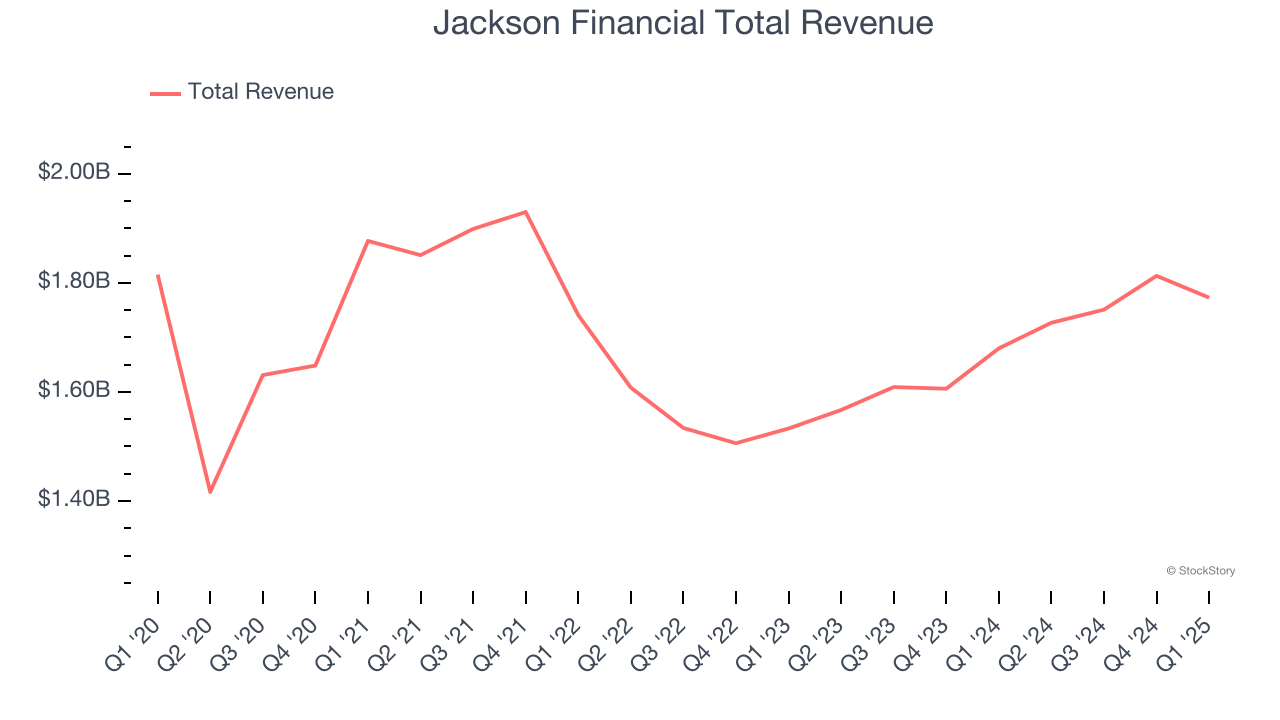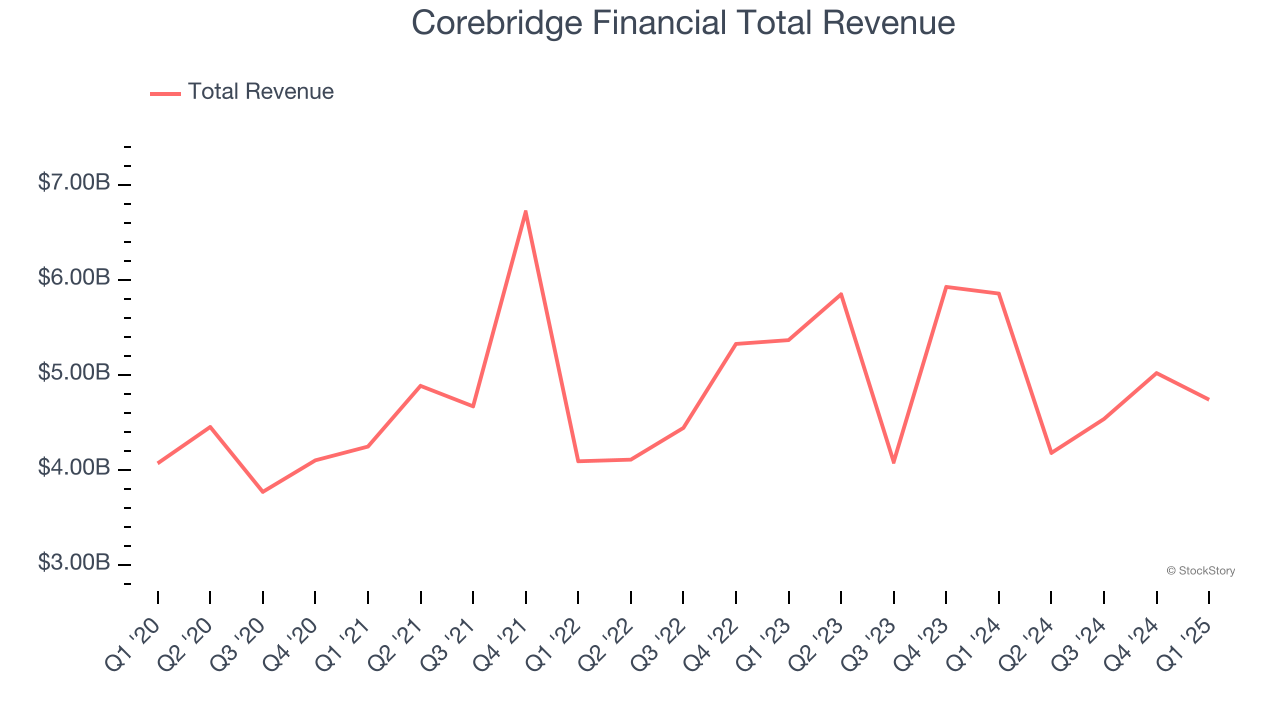
The end of an earnings season can be a great time to discover new stocks and assess how companies are handling the current business environment. Let’s take a look at how Jackson Financial (NYSE: JXN) and the rest of the life insurance stocks fared in Q1.
Life insurance companies collect premiums from policyholders in exchange for providing a future death benefit or retirement income stream. Interest rates matter for the sector (and make it cyclical), with higher rates allowing insurers to reinvest their fixed-income portfolios at more attractive yields and vice versa. Additionally, favorable demographic shifts, such as an aging population, are driving strong demand for retirement products while AI and data analytics offer significant opportunities to improve underwriting accuracy and operational efficiency. Conversely, the industry faces headwinds from persistent competition from agile insurtechs that threaten traditional distribution models.
The 15 life insurance stocks we track reported a softer Q1. As a group, revenues missed analysts’ consensus estimates by 3.1%.
While some life insurance stocks have fared somewhat better than others, they have collectively declined. On average, share prices are down 2.4% since the latest earnings results.
Jackson Financial (NYSE: JXN)
Spun off from British insurer Prudential plc in 2021 after more than 60 years as its U.S. subsidiary, Jackson Financial (NYSE: JXN) offers annuity products and retirement solutions that help Americans grow and protect their retirement savings and income.
Jackson Financial reported revenues of $1.77 billion, up 5.5% year on year. This print was in line with analysts’ expectations, but overall, it was a mixed quarter for the company.
Laura Prieskorn, President and Chief Executive Officer of Jackson, stated, “Our first quarter results demonstrate the continued strength of our business and progress on our strategic objectives. We achieved 9% growth in retail annuity sales compared to the same period last year with growth across all product lines. Our robust in-force book of business delivered free cash flow of $213 million, which was substantially higher than the first quarter of 2024, and delivered nearly $1 billion over the last 12 months ended March 31, 2025. Additionally, we are off to a positive start toward achieving our financial targets, growing our capital and RBC position in the first quarter of 2025, returning $231 million to common shareholders in the first quarter, and retaining healthy levels of excess cash at the holding company. We anticipate building upon this momentum through the remainder of 2025 and delivering on our mission of helping Americans secure their financial futures.”

Interestingly, the stock is up 4.9% since reporting and currently trades at $88.53.
Read our full report on Jackson Financial here, it’s free.
Best Q1: Corebridge Financial (NYSE: CRBG)
Spun off from insurance giant AIG in 2022 to focus on the growing retirement market, Corebridge Financial (NYSE: CRBG) provides retirement solutions, annuities, life insurance, and institutional risk management products in the United States.
Corebridge Financial reported revenues of $4.74 billion, down 19.1% year on year, outperforming analysts’ expectations by 7.9%. The business had a satisfactory quarter.

Corebridge Financial pulled off the biggest analyst estimates beat among its peers. The market seems happy with the results as the stock is up 7.2% since reporting. It currently trades at $35.30.
Is now the time to buy Corebridge Financial? Access our full analysis of the earnings results here, it’s free.
Weakest Q1: F&G Annuities & Life (NYSE: FG)
Founded in 1959 and serving approximately 677,000 policyholders who rely on its financial protection products, F&G Annuities & Life (NYSE: FG) provides fixed annuities, life insurance, and pension risk transfer solutions to retail and institutional clients.
F&G Annuities & Life reported revenues of $930 million, down 40.7% year on year, falling short of analysts’ expectations by 36.9%. It was a disappointing quarter as it posted a significant miss of analysts’ net premiums earned and EPS estimates.
F&G Annuities & Life delivered the weakest performance against analyst estimates and slowest revenue growth in the group. As expected, the stock is down 12.6% since the results and currently trades at $31.38.
Read our full analysis of F&G Annuities & Life’s results here.
Equitable Holdings (NYSE: EQH)
Tracing its roots back to 1859 as one of America's oldest financial institutions, Equitable Holdings (NYSE: EQH) provides retirement planning, asset management, and life insurance products through its two main franchises, Equitable and AllianceBernstein.
Equitable Holdings reported revenues of $3.78 billion, up 4% year on year. This result lagged analysts' expectations by 5.7%. It was a disappointing quarter as it also produced a significant miss of analysts’ EPS estimates.
The stock is down 1.9% since reporting and currently trades at $52.61.
Read our full, actionable report on Equitable Holdings here, it’s free.
Globe Life (NYSE: GL)
With roots dating back to 1900 and a rebranding from Torchmark Corporation in 2019, Globe Life (NYSE: GL) is an insurance holding company that offers life insurance, supplemental health insurance, and annuity products through various distribution channels.
Globe Life reported revenues of $1.48 billion, up 3.8% year on year. This print was in line with analysts’ expectations. Aside from that, it was a softer quarter as it produced a significant miss of analysts’ book value per share estimates and a miss of analysts’ EPS estimates.
The stock is down 1.7% since reporting and currently trades at $121.
Read our full, actionable report on Globe Life here, it’s free.
Market Update
Thanks to the Fed’s series of rate hikes in 2022 and 2023, inflation has cooled significantly from its post-pandemic highs, drawing closer to the 2% goal. This disinflation has occurred without severely impacting economic growth, suggesting the success of a soft landing. The stock market thrived in 2024, spurred by recent rate cuts (0.5% in September and 0.25% in November), and a notable surge followed Donald Trump’s presidential election win in November, propelling indices to historic highs. Nonetheless, the outlook for 2025 remains clouded by potential trade policy changes and corporate tax discussions, which could impact business confidence and growth. The path forward holds both optimism and caution as new policies take shape.
Want to invest in winners with rock-solid fundamentals? Check out our 9 Best Market-Beating Stocks and add them to your watchlist. These companies are poised for growth regardless of the political or macroeconomic climate.
StockStory is growing and hiring equity analyst and marketing roles. Are you a 0 to 1 builder passionate about the markets and AI? See the open roles here.






